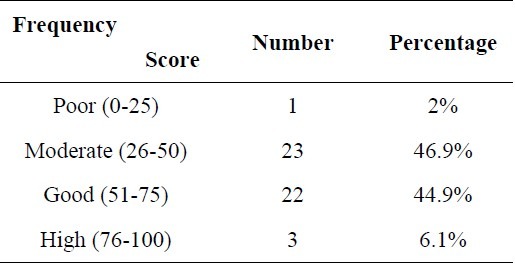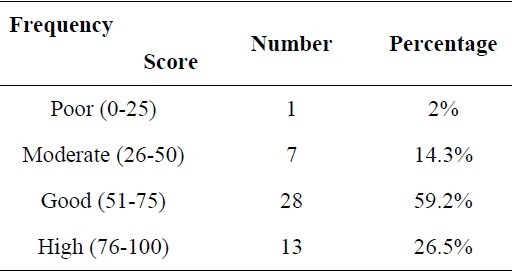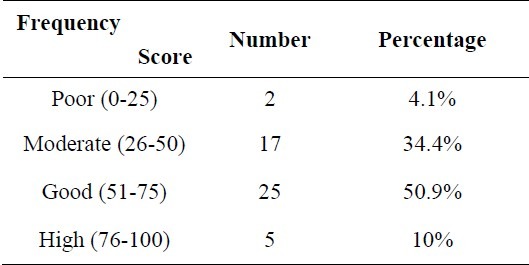Abstract
BACKGROUND:
One of the essential components of learning and educational program is evaluation or examination. There are various methods for evaluating clinical skills among which objective structured clinical examination (OSCE) has been recognized as the most reliable method for evaluation of the clinical skills.
METHODS:
This was a one-step single-group descriptive study which was conducted through a researcher-made questionnaire.
RESULTS:
Results indicated that the view of most of the students in OSCE test has been good in terms of equipment and facilities with relative frequency of 59.2 percent, conditions of holding the examination with relative frequency of 50.9% and total test with relative frequency of 55.1%; in terms of physical environment, students’ view was moderate with relative frequency of 469%.
CONCLUSIONS:
The results of the study showed that appropriateness of physical environment and equipment and facilities to hold OSCE can directly be involved in enhancing the quality of this test.
KEY WORDS: Evaluation, education, nursing students
Evaluation is a systematic process to collect, analyze and interpret the data which is implemented in order to control progression of the programs accurately toward predetermined goals and to understand the cost-effectiveness or determination of value of ongoing programs.1
George Miller proposed a framework for evaluation of clinical competence. In the lowest level of his proposed pyramid, knowledge (knows) is placed and in the next level there are respectively competence (knows how), performance (shows how) and action (does).
Accordingly, skill based assessment methods are placed at the most top level of the pyramid. One of these methods is objective structured clinical examination (OSCE).2 OSCE is a new form of evaluation which first was designed and implemented by Dundee in the mid-1970s in Scotland.3 OSCE method can easily evaluate learners’ basic and fundamental skills in cognitive, emotional and psychomotor domains and it can eliminate the effect of confounding variables by representing students’ skills in different stations.4 At the same time, this method is completely reliable, stable and practical.5 In OSCE, one or more assessment tools are used during a few separate stations, during which the test subjects encounter the patient or simulated patient (Standardized Patient; SP); each station usually takes 10-15 minutes to be completed. The entire test subjects move from one station to another with a specific order based on a predetermined program.6 In recent years, willingness to use this method has been created in evaluation of nursing students.7 In conducted surveys on nursing students in a university in the U.S., they believe OSCE was useful and must be replaced with other clinical assessments.8
In reviewing the satisfaction rate of family health students from OSCE method which was carried out by Eslamei et al. in Gorgan, the results indicated that students’ satisfaction with this method had a significant difference with the conventional method; furthermore, capabilities of OSCE test in performance measurement were stronger than in the conventional method.9
Generally, OSCE is the most appropriate method to evaluate clinical skills that is able to evaluate many skills which are not assessable through other conventional tests.10 This method is utilized in most of the American Medical Schools and also many assistance programs of this country and other countries. In addition, OSCE has been used more than eight years for License of Examination Board of Canada. Totally, it can be said that thank to this method, evaluation of clinical skills can be directly conducted with a standard, reliable and valid method.6
Methods
This was a one-step descriptive study which decided to evaluate nursing students’ view toward OSCE test.
The study environment was the Clinical Skills Laboratory of School of Nursing and Midwifery in Isfahan University of Medical Sciences. The study population included freshman nursing students of School of Nursing and Midwifery in Isfahan whose age range was between 18-23 years. The sample size included 50 freshman nursing students who were selected using census method.
The inclusion criteria included the students who had passed their clinical skills course and at least had the experience of two OSCE exams and exclusion criteria included unwillingness of the students in participating in the study. Data collection tools included a researcher-made questionnaire with 19 questions with Likert scale in which the questions were related to physical environment, equipment and facilities and conditions to hold OSCE. The comments of expert professors were used for content validity. Immediately after conducting the test and in a place out of test site, the questionnaires were given to the respondents to answer with sufficient comfort. The obtained data in this study were studied using descriptive statistics and frequency distribution.
Results
Based on the collected data, 22 students (44.9%) were males and 27 were females (55.1%); the minimum and maximum age of the students, respectively, were 18 and 23 years and the majority of the students were single (96%). In terms of gender, 55.1% were female. Also, 57.1% were dormitory residences.
According to table 1, the results indicated that physical environment in view of the students, respectively, was moderate and good with relative frequency of 46.9 and 44.9 percent. And based on table 2, in the view of most students, OSCE equipment and facilities were in a good situation with relative frequency of 59.2 percent.
Table 1.
Frequency distribution of the physical environment scores in view of the students

Table 2.
Frequency distribution of equipment and facilities scores in view of the students

Moreover, the results of table 3 indicated that conditions of holding the test was in a good situation in view of half of the participants with relative frequency of 50.9 percent. And, the results indicated that more than half of the stu-dents in general gave a good score to the OSCE test with relative frequency of 55.1 percent.
Table 3.
Frequency distribution of conditions of holding the test score in view of the students

Discussion
The findings of the study about the first question of the study on students’ view toward physical environment indicated that 46.9% described it as moderate and 44.9% described it as well, only 2% of the subjects believed physical environment was poor and 6.1% also believed it was perfect. However, these results indicated appropriateness of the environment for holding OSCE test. According to the study of Bahrei et al. also 59.2% of the study subjects assessed a proper environment of the test.11
According to the second question of the study, i.e., view of the students toward equipments and facilities, 59.2% of the subjects assessed them good, 14.3% moderate, 26.5% perfect and only 2% described them as poor. The results indicated that the majority of the study subjects assessed their equipments and facilities as good which can have a direct association in quality and promotion of this test. In general, according to the above results, it can be concluded that in terms of equipments and facilities, conditions of holding the test and its total score was good and in terms of physical environment, students’ view was moderate.
Based on the study of Ghehrzad et al., holding the evaluation through OSCE method causes the highest satisfaction rate in students.12 However, it seems it is required to conduct quantitative and qualitative researches in order to further enrich OSCE holding situation.
The authors declare no conflict of interest in this study.
References
- 1.Mohamadei N, Rafei Far SH. Health education curriculum. Tehran: Mehr Ravash Press; 2006. [Google Scholar]
- 2.Smee S. ABC of learning and teaching in medicine: skill based assessment. BMJ. 2003;326(7391):703–6. doi: 10.1136/bmj.326.7391.703. [DOI] [PMC free article] [PubMed] [Google Scholar]
- 3.Harden RM, Gleeson FA. Assessment of clinical competence using an objective structured clinical examination(OSCE) Med Educ. 1979;13(1):41–54. [PubMed] [Google Scholar]
- 4.Bromley LM. The Objective Structured Clinical Exam - practical aspects. Curr Opin Anaesthesiol. 2000;13(6):675–8. doi: 10.1097/00001503-200012000-00011. [DOI] [PubMed] [Google Scholar]
- 5.Wass V, Roberts C, Hoogenboom R, Jones R, Van d V. Effect of ethnicity on performance in a final objecti structured clinical examination: qualitative and quantitative study. BMJ. 2003;326(7393):800–3. doi: 10.1136/bmj.326.7393.800. [DOI] [PMC free article] [PubMed] [Google Scholar]
- 6.Malecan Rad E, Ain Alahi B. Educational Instruction booklet easy to hold an objective structured clinical exam. Department of Health and Medical Education. pp. 1–3. [Online]. Available from: URL: http://edu.mui.ac.ir/azm.htm/
- 7.Rushforth HE. Objective structured clinical examination (OSCE): Review of literature and implications for nursing education. Nurse Education Today. 2007;27(5):481–90. doi: 10.1016/j.nedt.2006.08.009. [DOI] [PubMed] [Google Scholar]
- 8.Alinier G. Nursing students’ and lecturers’ perspectives of objective structured clinical examination incorporating simulation. Nurse Educ Today. 2003;23(6):419–26. doi: 10.1016/s0260-6917(03)00044-3. [DOI] [PubMed] [Google Scholar]
- 9.Eslamei AA, Seifei A, Vagharei GR. Family Health Students RRSY satisfaction test method OSCE, in comparison with conventional tests (traditional) knowledge, attitude and skills necessary for entry to professional real situation 2001-2002. Iranian Journal of Medical Education. 2002;2:22. [Google Scholar]
- 10.Newble D. Techniques for measuring clinical competence: objective structured clinical examinations. Med Educ. 2004;38(2):199–203. doi: 10.1111/j.1365-2923.2004.01755.x. [DOI] [PubMed] [Google Scholar]
- 11.Bahrei Biba Baj N, Khadiv Zadeh T. A skills assessment test station and midwifery life satisfaction test subjects. Iranian Journal of Medical Education. 2003;1(10):71. [Google Scholar]
- 12.Ghehrzad MM, Shafei Pour Z, Mirzaei M, Kazem Nejad A. OSCE impact assessment and traditional methods of nursing student satisfaction. Iranian Journal of Medical Education. 2003;1(10):76. [Google Scholar]


